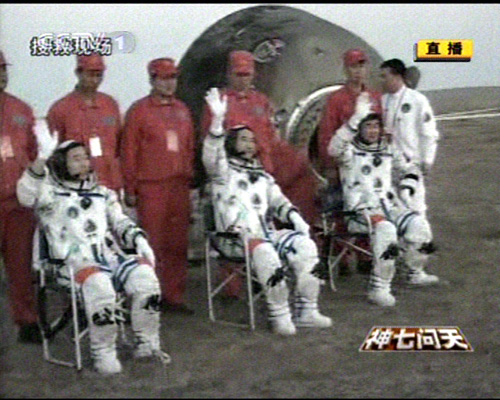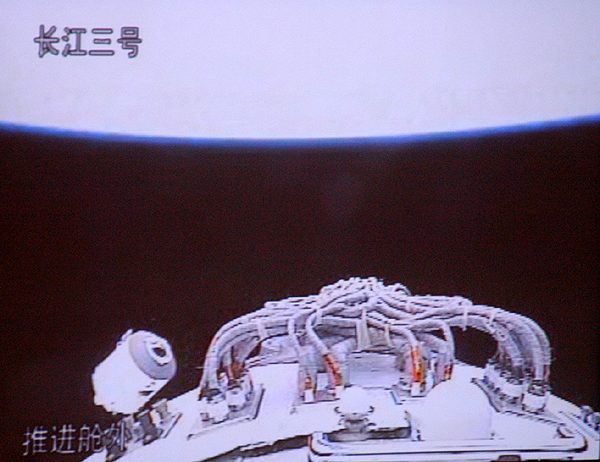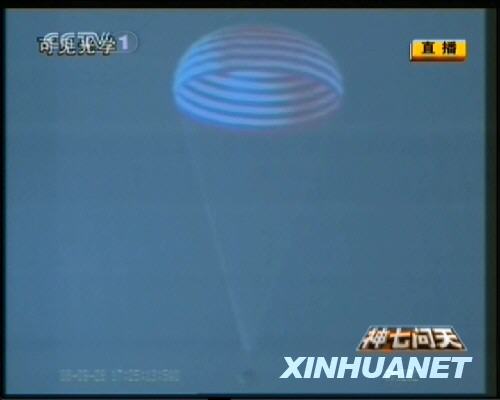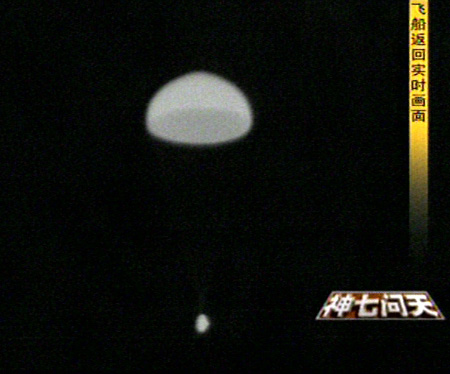|
CHINA SCIENCE AND TECHNOLOGY
NEWSLETTER
The Ministry of Science and Technology
People's Republic of China
|
|
|
N0.524 |
September 30,2008 |
|
|
|
|
|
|
|
|
IN THIS ISSUE
|
|
* Shenzhou 7 Lifted for Higher Missions
* China‘s First Spacewalk
* China's Third Manned Space Mission: A Complete Success
* China-Europe Energy & Environment Cooperation
* Gene Found Controlling Rice Yield
* World’s First Proactive Antivirus Software
|
Shenzhou 7 Lifted for Higher Missions

China's third manned spacecraft lifted off from the Jiuquan Satellite Launch Center in northwest China's Gansu province at 2110, September 25, 2008. The launch went through the following minutes and seconds: the escape tower was separated from the launch vehicle 120 seconds after the lift-off, the boosters 198 seconds, and the cowling 578 seconds. The Shenzhou 7 capsule was finally separated from the launch vehicle at 21:19:43, before entering the preset orbit.
The spacecraft is designed to fulfill an ambitious and risky mission: spacewalk, in an attempt to master the techniques of "extra-vehicular activity”, along with a range of scientific experiments, including launching a parasitic satellite, and satellite data relay. The mission is featured with increased technical difficulties, risks, workload, and requirements. The spacecraft was lifted off by a Long March carrier rocket for the 109th mission, or the 67th successful launch since October 1996. During the orbital flight, the spacecraft was measured, tracked, and operated by the ground control system, including a range of measuring boats deployed over the oceans. The ground control tracked down the astronauts’ physical conditions and activities, through teledata and video images sent back to the earth stations. The re-entry capsule carrying the three-man crew will land at a preset site in the middle part of the Inner Mongolia, when the orbital mission is completed.
Orbit Change
At 0404, September 26 (Beijing time), the Shenzhou 7 spacecraft successfully changed from an oval orbit to a near circular orbit 343 km away from the earth, under the instruction of the ground control in Beijing. Astronauts reported a range of physiological indicators as normal.
At 0016, the ground control talked to the onboard astronauts, listening to their health and activity reports. At 0403, the spacecraft started to change orbit under the instruction of the ground control. 64 seconds later, the spacecraft was back to a normal flight mode. Further calculations and measurements have proved the orbit change a success.
China‘s First Spacewalk

ZHAI Zhigang, one of the three-member crew, waving his hand in a spacewalk staged on September 27, 2008.


ZHAI displayed a Chinese national flag during his spacewalk on September 27, 2008.
ZHAI Zhigang, one of the three-member crew, opened the orbitor gate at 1633, September 27, 2008 (Beijing time), and made his first extra-vehicular activity. He was entirely out of the orbitor, and into the space at 16:44. He told the ground control that he has been out of the orbitor, and feeling well. He sent his greetings to the Chinese people, and the people of the world. ZHAI made the first stride of his spacewalk at 16:48, kicked off China’s first spacewalk. He displayed a Chinese national flag in the space. ZHAI completed the spacewalk, and returned to the orbitor at 16:59.
China's Third Manned Space Mission: A Complete Success

Astronauts waving their hands at the main landing site.




The re-entry capsule’s main parachute opened up on September 28, 2008.

Infrared image of parachuting.
The re-entry capsule was separated from the orbitor at 16:57, September 28, 2008. Its main parachute opened up at 17:26. The capsule touched down at 17:37 at a preset site in the middle part of Inner Mongolia. Astronauts walked out of the capsule. China's third manned space mission called a complete success.
Olympic Game Results in More S&T Applications
The practice of an S&T Olympic Game has enriched people’s understanding of innovations, and the S&T findings derived from the Beijing Olympic Game will find more applications in diverse areas, said WAN Gang, Vice-Chairman of the Chinese People’s Political Consultative Conference, and Chinese Minister of Science and Technology at a China Association for Science and Technology annual meeting held on September 17, 2008 in Zhengzhou.
WAN said that China’s automobiles burning new energies will enter a scale and commercial application stage, thanks to their improvements during the Beijing Olympic Game. China plans to launch demonstration projects for diverse new energy automobile in ten cities. The 3rd generation telecommunication technology has been tested thoroughly in the Game for further and nationwide applications. The application of solar power, wind power, and LED at the game venues will further enhance the scale and commercial application of the technologies.
WAN added that the environmental protection process widely applied in the Game will be used to improve energy efficiency and emission reduction. The enhanced steel building materials will yield new philosophy for architecture design in the future, and be extensively used in civic buildings.
According to a briefing, some 35,000 S&T personnel have been part of the S&T Olympic Game, working on 1,200 S&T projects. Meanwhile, the efforts have been supported by the international resources through international cooperation. The S&T endeavor in the Game has brought up a great number of technicians familiar with novel building design, new energy, and high technology, and nurtured up numerous basic research scientists.
WAN especially mentioned the carbon balance of the Beijing Olympic Game. Calculated on an international standard, the Game has a carbon dioxide emission worth 1.18 million tons. The improved traffic control, tree planting, energy efficiency, and environmental protection technologies have reduced carbon dioxide emission by at least 1.01-1.29 million tons.
|
INTERNATIONAL COOPERATION |
China-Europe Energy & Environment Cooperation
China-Europe Energy and Environment Program (EEP) convened a meeting on September 21, 2008 in Beijing, to launch a project to raise the awareness of energy efficiency in the selected sectors using the socalled benchmark management. Representatives and experts from the State Development and Reform Commission, ECD, EEP Office, and the Administrative Center for China’s Agenda 21 attended the meeting. The project, financed by the EU, will last for one year from September 2009 to the end of August 2010, with the following missions:
1) Organize studies in five major energy consuming sectors, including iron/steel, chemicals, building materials, non-ferrous metals, and textile, and prepare training and awareness raising materials and handouts for the targeted businesses.
2) Diffuse the benchmark methodology to at least 10-20 energy efficiency service centers in the major energy consuming sectors.
3) Support the demonstration activities organized by nine energy efficiency service centers in 9 major energy consuming sectors, and conduct case studies accordingly.
4) Make a comparison between China’s best practice and international practice, based on the experiments and pilot projects, and develop benchmark tools for 9 major energy consuming sectors.
5) Diffuse the benchmark methodology, tools, and associated economic benefits, and disseminate related materials.
6) Provide policy suggestions for the Chinese government on raising the energy efficiency of energy consuming sectors using benchmark management.
Gene Found Controlling Rice Yield
Chinese and American scientists said in a report published in the recent online issue of Nature Genetics that they have found a gene able to control rice grain-filling and yield. HE Zuhua, a Chinese Academy of Sciences biologist leading the study, explained that researchers screened out some mutated rice strains with noticeably low grain weight in the first place, and obtained a rice plant that does not have a normal grain weight due to the mutation. Further study of the plant has unveiled the mutation of GIF1. Experiments show that GIF1 would have a normal converting enzyme activity, without mutation. However, it could have a converting enzyme activity only 17% of the normal rice, if the gene mutated with insufficient expression. Based on the findings, researchers bred out a GM rice plant with an overexpressed GIF1. The new species produces the grains larger and heavier than the normal rice. The finding will help people to breed out new hybrid rice with larger and heavy grains.
World’s First Proactive Antivirus Software
It is reported from a seminar on new antivirus technology held on September 24, 2008 that Chinese scientists have successfully developed the world’s first proactive antivirus software, heralding a major new progress in the area. The new antivirus software is of a killing power as high as 99% in dealing with nearly a million types of computer viruses. The development marks an important boost to China’s information security.
A study team, headed by LIU Xu, a renowned antivirus expert, has developed a program able to perform proactive analysis and diagnosis, based on an antivirus expert system. The software is an integration of five core technologies, including dynamic simulation, automatic new virus identification, program behavior monitoring, automatic signature collecting, and visual information display. As a major breakthrough in developing proactive antivirus solutions, the novel software is able to identify, report, and clean up computer viruses, allowing China to take a lead in providing proactive antivirus solutions.
Enhanced Stem Cell Study
Statistics show that China has published more stem cell findings in SCI core journals. For example, both 2006 and 2007 have registered the Chinese stem cell papers exceeding 2,000 in number, close to the number published by the UK and France. Some stem cell findings published by Chinese scientists have taken a leading position in the world. A study of the number of Chinese stem cell papers published in SCI core journals and associated impact factors (calculated based on 2007 data) shows that 11 categories have produced an impact factor exceeding 35 for their stem cell papers in the SCI core journals. Of them, HAN Zhongchao of the CAMS Institute of Blood, ZHAO Chunhua with the CAMS Institute of Basic Medical Sciences, DENG Hongkui at Peking University Institute of Life Sciences, and MAO Ning of the Chinese Academy of Military Medical Sciences Institute of Basic Medical Sciences, have registered an impact factor at 157.253, 95.281, 93.370, and 75.111 respectively. Some of the Chinese papers have produced an individual impact factor reaching 10.896.
In recent years, both the central and local government has rendered the strong support to stem cell studies. For example, the National 973 Program and National 863 Program under the Ministry of Science and Technology, the National Natural Science Foundation, and the State Development and Reform Commission have financed major stem cell studies at different levels. Some local authorities established the earmarks to support stem cell studies. China has also hosted a range of domestic and international stem cell seminars, and published monographs on the subject. All these efforts have stimulated the development in the area, and narrowed down the gaps with the internationally advanced level, with some findings taking a leading position in the world.
Progresses for Breast Cancer Susceptibility Study
A study, led by WANG Hui, a research fellow at the Shanghai Institute for Biological Sciences under the Chinese Academy of Sciences, has made new progresses in understanding the association of common palb2 polymorphisms with breast cancer risks. The finding was published in the recent issue of journal Clinical Cancer Research. In collaboration with a team headed by SHEN Hongbing of Nanjing Medical University, researchers found that three single nucleotide polymorphisms (SNP: rs249954, rs120963, and rs16940342) have a susceptibility linking with the breast cancer occurrence in a female Chinese population, based on the PALB2 selected and genotyped in 1,049 patients with breast cancer and 1,073 cancer-free controls. The finding provides important theoretical evidences for screening breast cancer high-risk population and associated warning in China.
First Proprietary Fire Warning System for Nuclear Power Station
Not long ago, a nuclear and conventional island fire warning system, developed by Xi’an Nuclear Instrument Factory under the China National Nuclear Corporation, passed an approval check. As the first fire warning system specially designed for a nuclear power station, the new product is also a fire warning system with the highest technical specifications among the fire warning systems currently applied in the domestic nuclear power stations. The system, designed for No. 3 and No. 4 nuclear power generators in Qingshan Phase II project, has been delivered to the sites for installation and test.
According to a briefing, the new system enjoys the highest technical specifications among the fire warning systems applied in the domestic nuclear power stations, with a range of improvements. It has successfully stood up the tests of earthquake resistance, radiation resistance, high temperature endurance, and strong air current resistance.
Detecting Hidden Rail Problems Using Ultrasound Technology
Researchers at the Wuhan Institute of Rock and Soil Mechanics, part of the Chinese Academy of Sciences, have recently examined the selected parts of piles built for the Beijing-Shanghai Express Railway, using a newly developed RSM-SY7 system, an automatic supersonic unit designed for cross-hole pile testing. The new system makes a powerful technical tool for field testing of the Beijing-Shanghai Express Railway in a timely and efficient manner.
As an advanced four-channel pile section detector, the new system enjoys a noticeably enhanced test efficiency and shortened test time, compared with single or duel channeled system. It would take one hour for a single channeled system, or some 30 minutes for a duel channeled system to complete the test of a pile 50m long with 6 test sections. Now it takes less than 10 minutes for the new system to do the job.
Comments or inquiries on editorial matters or Newsletter content should be directed to:
Mr. XU Chaoqian, Department of International Cooperation, MOST 15B, Fuxing Road, Beijing 100862, PR China Tel: (8610)58881360 Fax: (8610) 58881364
http://www.most.gov.cn | 
